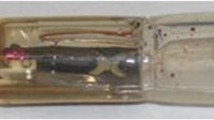Abstract
Purpose
Patients with programmable ventriculoperitoneal (VP) shunt valves undergo multiple skull radiographs to evaluate for setting changes resulting from MRI. Our purpose was to determine the rates of inadvertent, MRI-related, programmable VP shunt valve setting changes.
Materials and methods
In this retrospective cohort with a study period of January 2015–December 2018, we reviewed the pre- and post-MRI skull radiographs of patients with programmable VP shunts and collected the following data: Demographics, commercial type of the valve used, magnetic field strength of the MRI device used, and whether a setting change occurred. We used the chi-square test to identify variables associated with valve setting change.
Results
We identified 210 MRI exposure events in 156 patients, and an MRI-related valve setting change rate of 56.7%. The setting change rate was significantly higher with higher magnetic field strength (p = 0.03), and with Medtronic Strata™ valves compared to Codman Hakim™ valves (p < 0.0001).
Conclusion
Inadvertent, MRI-related shunt valve setting changes are frequent with valves that lack a locking mechanism. Therefore, we suggest that when feasible, the clinicians could opt to manually reprogram the valves after the MRI to the preferred setting without the need for pre- and post-MRI radiographs. We believe that this protocol modification could help reduce ionizing radiation exposure and cost. Manufacturers may consider incorporating locking mechanisms into the design of such devices in order to reduce the unintended setting change rates.
Similar content being viewed by others
Availability of data and material
Available upon request.
Code availability
Not applicable.
References
Ahn ES, Bookland M, Carson BS, Weingart JD, Jallo GI (2007) The Strata programmable valve for shunt-dependent hydrocephalus: the pediatric experience at a single institution. Childs Nerv Syst ChNS Off J Int Soc Pediatr Neurosurg 23(3):297–303
Berlin L (2007) Accuracy of diagnostic procedures: has it improved over the past five decades? AJR Am J Roentgenol 188(5):1173–1178
Capitanio JF, Venier A, Mazzeo LA, Barzaghi LR, Acerno S, Mortini P (2016) Prosepective study to evaluate rate and frequency of perturbations of implanted programmable Hakim Codman valve after 1.5-Tesla magnetic resonance imaging. World Neurosurg 88:297–299
Giancardo L, Arevalo O, Tenreiro A, Riascos R, Bonfante E (2018) MRI compatibility: automatic brain shunt valve recognition using feature engineering and deep convolutional neural networks. Sci Rep 8(1):16052
Lavinio A, Harding S, Van Der Boogaard F, Czosnyka M, Smielewski P, Richards HK, Pickard JD, Czosnyka ZH (2008) Magnetic field interactions in adjustable hydrocephalus shunts. J Neurosurg Pediatr 2(3):222–228
Medtronic PS Medical Adjustable Strata Valves; The ISPN Guide to Pediatric Neurosurgery https://www.ispn.guide/hydrocephalus-and-other-anomalies-of-csf-circulation-in-children/the-ispn-shunt-guide/medtronic-ps-medical-adjustable-strata-valves/. Accessed 4 Oct 2020
Zabramski JM, Preul MC, Debbins J, McCusker DJ (2012) 3T magnetic resonance imaging testing of externally programmable shunt valves. Surg Neurol Int 3:81
Zemack G, Romner B (2000) Seven years of clinical experience with the programmable Codman Hakim valve: a retrospective study of 583 patients. J Neurosurg 92(6):941–948
Acknowledgements
We acknowledge Zafer Keser, MD, for his valuable contributions to the statistical analysis; and our neurosurgical colleagues Drs. Spiros Blackburn, Joseph A. Cochran, Mark Dannenbaum, Arthur L. Day, Yoshua Esquenazi, Jessica R. Stark, and Nitin Tandon for providing us their valuable insights regarding their clinical practices relevant to this study.
Author information
Authors and Affiliations
Contributions
Study design by ABS, EEB, FEU; data collection, data analysis, and manuscript writing by FEU; critical review by ABS, EEB.
Corresponding author
Ethics declarations
Ethics approval
Approved by the Institutional Review Board (IRB).
Consent to participate
Informed consent waived by IRB.
Consent for publication
Informed consent waived by IRB.
Conflict of interest
The authors declare no competing interests.
Additional information
Publisher’s note
Springer Nature remains neutral with regard to jurisdictional claims in published maps and institutional affiliations.
This article is part of the Topical Collection on CSF Circulation
Rights and permissions
About this article
Cite this article
Ucisik, F.E., Simonetta, A.B. & Bonfante-Mejia, E.M. Magnetic resonance imaging–related programmable ventriculoperitoneal shunt valve setting changes occur often. Acta Neurochir 164, 495–498 (2022). https://doi.org/10.1007/s00701-021-05060-2
Received:
Accepted:
Published:
Issue Date:
DOI: https://doi.org/10.1007/s00701-021-05060-2




